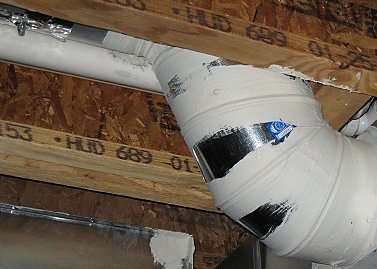How Much Does Duct Sealing Cost in Denver?
All ductwork leaks to some extent. Which means all homeowners waste money every month via leaky ductwork (and, yes, that includes you).
In fact, according to Energy.gov, the typical home loses around 30% of conditioned air due to ductwork leaks. Which basically means, for every $100 you spend on heating/cooling your home, you’re throwing $30 in the trash.
The good news is that duct sealing can close off those costly leaks. But how much does that cost? Well, it depends, but the typical cost of duct sealing in Denver ranges from $1,000–$4,000+.
The price you’ll end up paying all depends on:
- The size of your home
- The complexity of the job
- The duct sealing method used
- The professional you choose
We’ll explain the 4 factors above and how they affect your final duct sealing cost.
Cost factor #1: The size of your home
The larger the home, the more duct sealing will cost.
That’s because a larger home typically needs more vents to pump cold/warm air throughout the entire home. And the more vents, the more ductwork to check/seal, which raises labor and material costs.
For example, the cost to seal ductwork in a 5,000 sq/ft+ home could cost up to $1,200 more than a 1,000 sq/ft home with equally leaky ductwork.
Cost factor #2: The complexity of the job
The more labor-intensive the duct sealing project, the higher the cost.
More complex duct sealing jobs take longer (which raises the cost of labor), require more materials and might even require special tools that cost more to operate.
Situations that might require more labor/materials/tools than the typical duct-sealing job include:
- Needing to repair/replace severely leaky ducts
- Having to cut into walls to access ductwork
- Duct sealing in a retrofit system vs sealing ducts at time of installation
Cost factor #3: The duct sealing method used
Two categories of duct sealing include:
- Manually applied sealant: the less expensive option
- Injected aerosol (“Aeroseal”): the more expensive option
Manual duct sealing
Ductwork sealed manually with mastic. Source: Oregon.gov
Manual duct sealing uses either mastic or mastic tape to seal duct leaks. This option is great for sealing large holes in the ductwork and/or to seal connections. This option is generally cheaper than Aeroseal because the materials themselves are cheap and homeowners can typically handle this job themselves.
The downside:
Manual duct sealing methods cannot find or seal leaks that are hidden in walls and other hard-to-reach areas. This method also relies on the limited visual inspection of the homeowner/tech to find all the tiny holes and cracks in ductwork.
Aeroseal
A tech sealing ductwork using the Aeroseal method. Source
Aeroseal works by injecting aerosol particles directly into the ductwork. This method works to seal 100% of leaks up to ⅝ inches. Because Aeroseal seals ducts from the inside out, it can reach leaks in very hard-to-reach places.
The downside:
Aeroseal can’t seal larger leaks and is more expensive than manual methods. But remember, to access most ductwork, manual sealing jobs often require cutting into walls, which is expensive when you factor in the repair work and makes the overall price comparable to the AeroSeal method.
Cost factor #4: The professional you choose
Different companies charge different prices for duct sealing. And, typically, the higher-quality companies charge higher prices.
Our advice? When it comes to duct sealing, you don’t want to risk hiring a low-priced contractor. Why? Well, a sloppy duct sealing job can lead to:
- Higher energy bills
- Damage to your heating/cooling system
- Poor indoor air quality
- Lower indoor comfort levels
Instead, make sure you choose a company that guarantees they will:
- Inspect the entire duct system (even in hard-to-reach areas)
- Seal large leaks manually (if needed) but also seal all small leaks with an aerosol-based sealant.
- Seal all registers tightly to the ducts
- Repair or straighten damaged/disconnected/tangled ducts
- Evaluate airflow after completing duct sealing
Need help from a Colorado Plumbing, Heating, Cooling, or Electrical Specialist?
For your convenience, you can request an appointment in one of two ways:
- Call us at (303) 436-2525 for immediate assistance.
- Click on the button below to schedule your appointment online.
Related Reading
Join Our Email Newsletter
Receive updates, current news, promotions, and industry tips.


